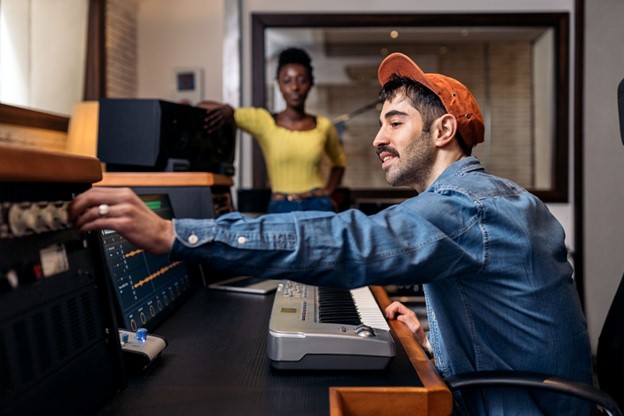
Musicians and independent artists must understand what is involved in music production. Music supervisors, filmmakers, and other creatives frequently utilize custom-made reggae music that’s original in their projects.
It’s helpful because they can work with the musician to create a more customized piece of music, snippet, or song that really stands out and works well for their brand.
But how would you produce custom music?
Music production is the process covering every phase within the creation, writing, mixing, and mastering of a piece of music. It’s an umbrella term that encompasses all the steps involved in making music from start to finish.
The custom part is when you know precisely what you are using the music for from the beginning so you can tailor it to your liking.
Here’s a handy breakdown and guide to help you when producing custom music for your next project or campaign.
Equipment and Hardware
Before you begin, you must ensure that you either work with an independent artist, musician, or producer who has the following equipment and hardware:
- Computer
- Digital Audio Workstation (DAW)
- Monitoring Equipment (speakers, headphones)
- Audio Interface
- Microphone
- Instruments (virtual or real)
Recording and audio software on the computer can easily record vocals and instruments without needing a music studio. However, there are things you need to take into account for your audio space, such as soundproofing, to get a clear tone.
The Story and Briefing
To begin, you must know what you hope to achieve with your project. For instance, if you’re finding a music license for your podcast, the music producer or composer needs to know what your podcast is about, including themes, episodes, and the all-encompassing value. If you’re creating a video ad, you can explain the goal and significance within the visual elements to inspire music that will enhance it.
Let’s say you’re working on creating intro and outro music to compliment your voice. You work with the person developing your music to create a strong vision for your material. A music composer or producer may be wearing multiple hats during the workflow.
The Recording
Next, the musician or the independent artist will lay down a recording. The recording process can take weeks or months, depending on the number of instruments and vocals. If you want more creative control over the finished product, you should offer creative insight and notes for the musician to help during the recording.
Many artists self-produce or use audio software and equipment from a home studio. It can be less costly for you to collaborate with a lesser-known artist. You can also benefit from access to each other’s social media platforms to obtain new followers and fans, grow your audience, and build brand awareness.
Mixing and Mastering
Once you have all of your audio tracks recorded, the next step is doing the mixing. Many audio software programs are available online, some even free to use. You should work with the producer or musician to develop the right balance of vocals, instruments, and sounds to achieve your desired music.
Suppose you are working to produce on your own (or even to become more knowledgeable about the mixing/mastering process). In that case, you need to become familiar with various effects for music production, including:
- Addition of effects on your tracks such as EQ, Reverb, Compression, and Distortion.
- Balancing your audio levels (panning) to make individual tracks stand out more or less to the listener.
- Re-recording or removing unnecessary sounds like hums or breaths.
You should ensure that you listen through the raw recordings to make notes on how you want to adjust the sound to achieve your ideal mix, so it’s ready for television, radio, podcast, or other mediums.
Once you have completed the mixing process, the master puts your recording in its final format, such as an MP3. The idea is to balance all of the elements in their blended form and ensure that your music will be heard the way you intend it to be.
Release and Distribution
If you are working with an artist, ensure that you adhere to copyrights and obtain the licenses you need to utilize the music for your project(s). The musician may want to release or distribute the music for streaming, making it available to other creatives. This, along with other terms regarding the piece of music, is something you need to discuss and have within your contract or agreement when licensing or obtaining the music for your project.
Custom music has numerous benefits, providing you with creative control and significantly impacting your audience. Hopefully, this guide can help take you confidently through the process of developing custom music for your upcoming projects, launches, and campaigns. You could showcase the next “Amazing” song for your listeners!
RELATED: Stefflon Don Talks Dancehall Music Vs Crime – Watch Interview
RELATED: Queen Ladi Releases “One Man To Mi Goodie” ft. Dowey Music Video
RELATED: Skeng and Nicki Minaj’s “Likkle Miss Remix” Official Music Video Out Now – Watch Video





